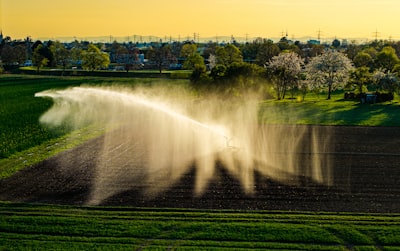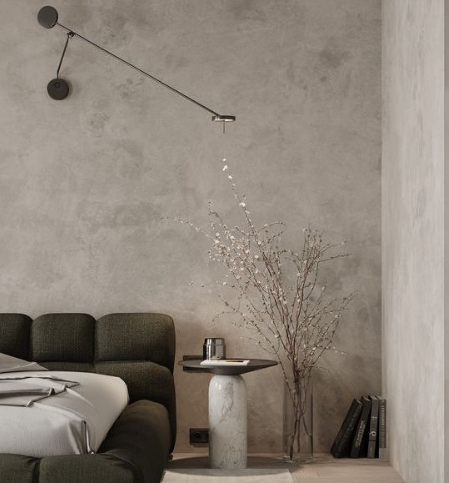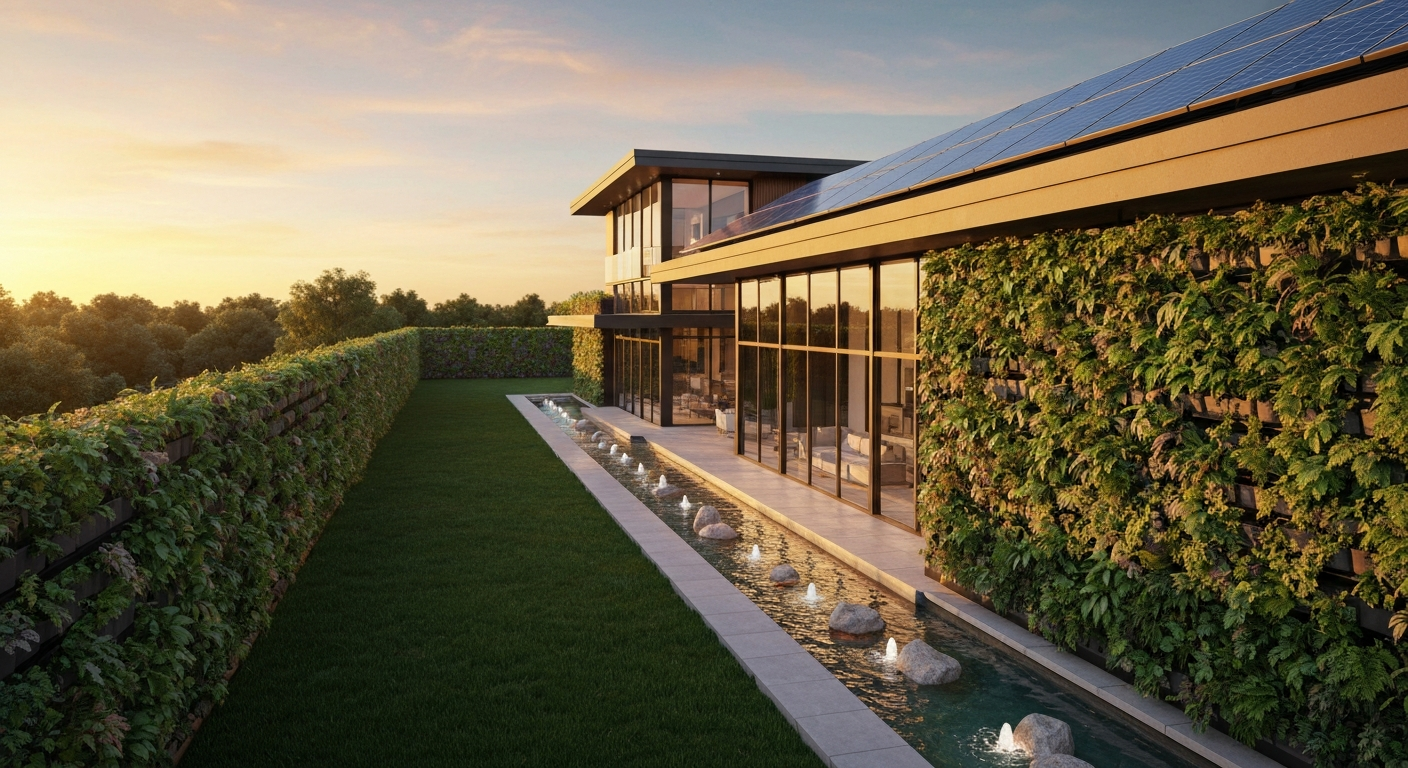Key Highlights
- Sustainable luxury redefines home design by integrating the natural world into your living spaces.
- Biophilic design uses natural elements to improve well-being and reduce stress.
- Key interior design trends focus on organic materials, natural light, and seamless indoor-outdoor living.
- Incorporating green technology and smart systems enhances energy efficiency in luxury homes.
- Wellness-focused features like indoor greenery and water elements improve air quality and promote relaxation.
- Sustainable homes often see a higher resale value due to increased buyer demand for eco-conscious living.
Introduction
A quiet but powerful shift is transforming the world of luxury home design. Today, opulence is not just about lavish finishes; it's about creating spaces that are both beautiful and restorative. This new standard, known as sustainable luxury, thoughtfully integrates the natural world into your home's architecture and interiors. By using natural materials and embracing eco-conscious principles, you can design a home that is a true sanctuary, connecting you more deeply with your environment while prioritizing your well-being.
Redefining Sustainable Luxury in Home Design
Sustainable luxury in home design moves beyond simple aesthetics to create a living experience rooted in wellness and nature. At the heart of this movement is biophilic design, a philosophy centered on our innate human tendency to connect with the natural world. It intentionally brings elements of nature into luxury homes to foster a sense of calm and balance.
This approach is about more than just adding a few plants. It involves a holistic application of the principles of biophilic design across your entire home. From the building materials you choose to the way light fills a room, every detail is considered to create a nourishing and restorative environment.
1. Biophilic Elements: Integrating Nature Into Modern Luxury Homes
The core idea of biophilic design stems from the biophilia hypothesis, which suggests that humans have an intrinsic need to connect with nature. In modern luxury homes, this philosophy translates into creating spaces that celebrate the beauty of the natural world. By integrating natural elements, you can transform your home into a sanctuary that mirrors your outdoor surroundings, fostering a deeper bond between you and your environment.
This design approach is proven to reduce stress and enhance mental health. Key features of biophilic design in modern luxury homes include:
- The use of natural materials like wood and stone.
- Maximizing natural light and views of the outdoors.
- Incorporating indoor greenery and water features.
Implementing these elements creates a harmonious living atmosphere that promotes creativity and ecological awareness. Each room becomes a tranquil space that resonates with our affinity for nature, enhancing your overall well-being and creating a more restorative home.
2. Eco-Friendly Building Materials Used in High-End Residences
Choosing the right building materials is fundamental to sustainable luxury. High-end residences now prioritize eco-friendly and sustainable materials that are both beautiful and environmentally responsible. The focus is on natural materials that bring the essence of the outdoors inside, creating a warm and authentic atmosphere. Using locally sourced materials also helps reduce energy consumption and supports sustainable practices.
Some of the most popular green building materials in high-end homes include:
- Reclaimed wood for flooring or accent walls, which adds character while preserving forests.
- Natural stone like marble, slate, or travertine for countertops and walls.
- Organic materials and textiles made from plant-based fibers for a soothing feel.
These choices contribute to a healthier indoor environment and can even help your home achieve certifications for sustainability. By selecting organic materials like wood and stone, you create a space that feels grounded and connected to the earth.
3. Innovative Green Technologies for Smart, Luxurious Living
Modern luxury is increasingly defined by the seamless integration of smart home automation and green technologies. These innovations not only offer convenience but also significantly boost energy efficiency, making your home both intelligent and sustainable. Green architecture has embraced technologies that help you live more consciously without sacrificing comfort.
In the luxury real estate market, smart systems are becoming a standard feature. Some of the most impactful green technologies include:
- Retractable skylights that allow you to control natural light and airflow.
- Intelligent lighting systems designed to align with the body’s natural circadian rhythms.
- Automated temperature controls that optimize energy use throughout the day.
These forward-thinking solutions allow you to create a living environment that is responsive to your needs and the changing seasons. By adopting these technologies, you can enjoy a luxurious lifestyle that is also mindful of its environmental footprint.
4. Maximizing Natural Light and Views With Architectural Design
A key principle of sustainable luxury is harnessing natural light and framing views of the surrounding landscape. Thoughtful architectural design can flood your interiors with daylight, creating a seamless connection between your home and the outdoors. This not only reduces the need for artificial lighting but also provides continuous visual stimulation that enhances your mood and cognitive function.
Architects use several techniques to achieve this bright and airy feel. Common design elements include:
- Floor-to-ceiling windows that offer unobstructed views.
- Expansive glass walls and skylights that illuminate even interior spaces.
- Open-plan layouts that allow light to flow freely throughout the home.
By orienting your home’s layout to capture the scenery, you can turn every window into a living piece of art. This approach blurs the lines between inside and out, creating an inviting and harmonious environment that keeps you connected to the natural landscape.
5. Energy-Efficient Features That Elevate Modern Luxury Homes
Energy efficiency is no longer a niche concern; it is a hallmark of modern luxury home design. Trends in luxury homes have increasingly promoted sustainability by integrating features that reduce energy consumption while enhancing comfort. This approach proves that you don't have to choose between opulence and eco-friendliness.
Many luxury design trends promote energy efficiency by working with nature rather than against it. Some of these features include:
- Designs that maximize natural ventilation to cool the home without relying on air conditioning.
- Strategic placement of windows and skylights to harvest daylight and reduce electricity use.
- The inclusion of green space, like rooftop gardens, which can help insulate the home.
By embracing these passive design strategies, modern luxury homes reduce their environmental impact and create a healthier living space. This focus on energy efficiency adds long-term value and demonstrates a commitment to responsible living.
6. Water Conservation Solutions in Upscale Home Design

Beyond their aesthetic appeal, water features in upscale home design are now being engineered with conservation in mind. While indoor fountains and outdoor reflecting pools add tranquility, sustainable design ensures they are part of a responsible water management system. Integrating water elements in a way that is both beautiful and eco-conscious is a key aspect of modern luxury.
Designers use several methods to achieve both beauty and conservation. These solutions include:
- Rainwater harvesting systems that collect water for irrigation or to supply water features.
- Native landscaping that requires less water than traditional gardens.
- High-efficiency irrigation systems that minimize water waste.
Incorporating these water elements thoughtfully enhances the sensory experience of your home. You can enjoy the calming sounds and visual appeal of water features while knowing that your home is designed for responsible water use.
7. Wellness-Focused Interiors: Indoor Greenery and Air Quality
Sustainable luxury places a strong emphasis on wellness, and a major part of that is creating a healthy indoor environment. Improving air quality is a top priority, and one of the most beautiful ways to achieve this is through indoor greenery. Plants are natural air purifiers that can significantly enhance the atmosphere of your home while also boosting your mental health.
Bringing plants indoors offers a wide range of benefits. Some key advantages of indoor greenery include:
- Improved air quality, as plants filter common pollutants and increase oxygen levels.
- Reduced stress and enhanced cognitive function, as exposure to greenery is proven to be calming.
- Aesthetic appeal, with living walls and vertical gardens acting as living art.
By selecting plants for both their air-purifying properties and their beauty, you can ensure your home provides fresh air and a constant connection to nature. This focus on air quality and wellness turns your living space into a true sanctuary.
8. Sustainable Outdoor Spaces and Seamless Indoor-Outdoor Living
Creating a seamless connection between your indoor and outdoor spaces is a signature of sustainable luxury design. This approach erases the traditional boundaries of the home, inviting you to experience your surrounding environment as an extension of your living area. The goal is to create a fluid transition that encourages you to move freely between indoors and out, enjoying fresh air and natural light.
Architects achieve this seamless indoor-outdoor flow through several design strategies. These often include:
- Large sliding glass doors or retractable walls that can completely open up a room to the outside.
- Consistent flooring materials that extend from the living room to an outdoor patio.
- Open-air rooms and covered breezeways that merge the structure with the natural environment.
By designing outdoor spaces with luxury amenities like comfortable furniture and fire pits, your home encourages relaxation and social interaction in harmony with nature. This creates a lifestyle that is deeply connected to the outdoors.
9. Artisanal Craftsmanship With Sustainable Materials
Sustainable luxury also celebrates the unique touch of artisanal craftsmanship. By commissioning skilled artisans to work with sustainable materials, you can incorporate one-of-a-kind elements into your home that tell a story. This approach adds a layer of warmth and personality that mass-produced items simply cannot match. It’s about creating a space that feels both elegant and deeply personal.
Artisans can transform sustainable materials into stunning focal points within your home. Examples of this include:
- Handcrafted marble countertops or terrazzo flooring that showcase the beauty of natural stone.
- Custom accent walls or exposed beams made from reclaimed or natural wood.
- Woven cane panels and textured clay tiles that add tactile authenticity.
Collaborating with local craftspeople not only results in unique design features but also supports a more sustainable and community-focused approach to building. These handcrafted elements embody the philosophy of biophilic design, bringing the essence of nature indoors with skill and artistry.
10. Iconic Architecture Firms Pioneering Green Luxury Trends
The movement toward sustainable luxury has been championed by iconic architecture firms and home builders across the United States and the world. These pioneers have set new standards for homes that celebrate nature, with visionaries like Frank Lloyd Wright laying the groundwork for architecture that harmonizes with its environment. Today, many firms are leading the charge in green luxury trends, creating homes that are both stunning and sustainable.
Firms like Olson Kundig and Howard Backen are notable for their work in this area, inspiring homeowners and builders alike. Their designs often exemplify the principles of biophilic design on a grand scale. Here are a few notable firms and their contributions:
- Olson Kundig — Known for designs featuring pivoting glass walls, exposed steel, and raw wood.
- Howard Backen — Creates rustic yet elegant estates that blend seamlessly with the natural landscape.
- Aman Resorts — A global brand that integrates biophilic design into luxury properties.
These leaders and many others are proving that luxury and sustainability can go hand in hand. Their work showcases how thoughtful design can create homes that not only shelter but also heal and inspire.
11. Smart Home Automation for Sustainable Living
Smart home automation is a powerful tool for achieving a more sustainable living space. Beyond convenience, these systems give you precise control over your home’s energy consumption, helping you manage your built environment more efficiently. This technology allows you to reduce your carbon footprint while maintaining a high level of comfort and luxury.
Smart systems can be integrated into nearly every aspect of your home. Key applications for sustainable living include:
- Automated lighting that adjusts to the time of day and natural light levels.
- Smart thermostats that learn your habits and optimize heating and cooling.
- Automated window shades that help regulate indoor temperature by controlling sunlight.
By leveraging smart home automation, you can create a living space that is responsive, efficient, and perfectly attuned to your lifestyle. This technology is a cornerstone of modern sustainable luxury, making it easier than ever to live responsibly without compromise.
12. How Sustainable Design Boosts Home Resale Value
Investing in sustainable design is not just good for the planet; it's also a smart financial decision that can significantly boost your home's resale value. In the luxury real estate market, buyers are increasingly prioritizing wellness, sustainability, and mindful living. Homes that incorporate these features are more appealing and stand out in luxury home marketing efforts.
The focus on sustainability in interior design and architecture has a direct impact on long-term value. Here’s how sustainable design adds to home resale value:
- Increased buyer demand for wellness-centered and eco-conscious homes.
- Lower utility costs due to energy-efficient features, which is a major selling point.
- Timeless appeal, as natural materials and nature-inspired designs age gracefully.
Green architecture trends have made sustainability a premium feature. Homes with biophilic elements and eco-friendly systems often command higher prices and spend less time on the market. Buyers recognize that these features offer a better lifestyle and a solid investment.
Interior Design Trends in Luxury Sustainable Homes
The principles of sustainable luxury extend deep into the interior design of your home. Current interior design trends in luxury homes are all about embracing authenticity and a connection to nature. This means moving away from sterile, monochrome palettes and toward spaces that feel warm, grounded, and alive with texture.
The focus is on using organic materials and celebrating tactile sensations. From the fabrics you choose for your furniture to the finishes on your walls, every element is an opportunity to bring the calming influence of nature indoors. The following trends showcase how to create an interior that is both sophisticated and deeply restorative.
Natural Textures and Organic Fabrics in Upscale Interiors

Creating a luxurious and sustainable interior is all about celebrating natural textures and tactile authenticity. In upscale interiors, designers are using a variety of materials that bring warmth and visual softness to a space. These elements provide a feeling of groundedness and understated elegance, making your home feel like a nurturing retreat.
You can incorporate these textures in many ways throughout your home. Popular choices include:
- Limewash walls and textured clay tiles that add depth and a handcrafted feel.
- Exposed wooden beams that create a sense of harmony with nature.
- Organic fabrics like linen, wool, and woven cane for furniture and decor.
Instead of highly polished surfaces, many luxury homes now favor materials that wear beautifully over time, like honed travertine or hand-hewn oak. These natural textures tell a story and add a layer of charm that enhances the entire space.
Low-VOC Finishes and Eco-Conscious Decor Choices
A truly sustainable home is a healthy home. Choosing low-VOC (volatile organic compound) finishes and eco-conscious decor is crucial for ensuring better air quality and a non-toxic living environment. VOCs are harmful chemicals found in many conventional paints, sealants, and furnishings, so opting for alternatives is an important step in wellness-focused design.
Making eco-conscious choices extends to every aspect of your decor. Consider these design elements:
- Using paints and stains that are labeled as low-VOC or zero-VOC.
- Selecting furniture made from solid, natural wood instead of particleboard with chemical adhesives.
- Choosing decor pieces from artisans who use sustainable and recycled materials.
By prioritizing these healthier options, you create a space that is not only beautiful but also supports the well-being of everyone who lives there. These thoughtful choices are key design elements in a home that is both luxurious and responsible.
Conclusion
In conclusion, sustainable luxury is not just a trend; it's a transformative approach that redefines how we think about home design. By integrating biophilic elements, eco-friendly materials, and innovative technologies, homeowners can create spaces that are both luxurious and environmentally responsible. This modern take on luxury ensures that every aspect of a home contributes to a healthier planet while maintaining aesthetic appeal and comfort. As you embark on your journey to design a sustainable luxury home, remember that each choice you make can lead to a positive impact on your well-being and the environment. If you're ready to elevate your home's sustainability, get a free consultation to explore how you can redefine luxury in your living space.





